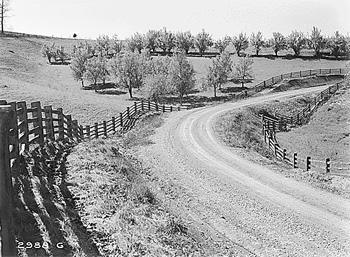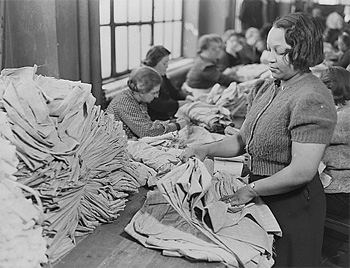
A 1939 survey asked Americans to name the best and worst things President Roosevelt had done. The top
answer to both questions was the WPA.
The WPA – the Works Progress Administration – was a federal program meant to provide jobs to people who could not find work. Under the WPA, the government paid people to sew clothes, paint murals, can vegetables, cook school lunches, and build everything from hospitals and schools to sidewalks and swimming pools.
It was an idea born of desperation. For two years, Franklin Delano Roosevelt’s administration had been trying to fight the Depression. But various projects meant to provide jobs and stimulate the economy still hadn’t lifted the country out of its economic doldrums.
In 1935, FDR proclaimed that the country was on an “unmistakable march toward recovery.” He pointed out that “for the first time in five years the relief rolls have declined instead of increased during the winter months.”
Still, he acknowledged, “while business and industry are definitely better, our relief rolls are… too large.”
The New Dealers had tried various programs to attack unemployment. They had provided work for hundreds of thousands of jobless young men in the Civilian Conservation Corps. They had launched a big program to build public works such as bridges and dams, the Public Works Agency, hoping to stimulate the construction business and provide jobs. But the PWA’s big projects were slow to get started. It wasn’t employing people fast enough.
The new weapon FDR proposed in the fight against “enforced idleness” was the WPA. It would do smaller projects that could be set up quickly and put people to work right away.
It was immediately controversial.
“It seemed like socialism,” says historian Lorraine McConaghy, from the Museum of History and Industry in Seattle. “Many people thought Roosevelt was a dangerous person with dangerous ideas.”
In fact, the idea of a massive government program to hire unemployed people gave Roosevelt himself pause. Many historians argue that he was at heart a fiscal conservative, and he didn’t want to plunge the government into debt. But it seemed to him that the government had to do something.
“The country demands bold, persistent experimentation,” he said in an address at Oglethorpe University. “It is common sense to take a method and try it; if it fails, admit it frankly and try another. But above all, try something.”
So why not simply hand money out to people? Why a jobs program?
Roosevelt later wrote: “Providing useful work is superior to any and every kind of dole.”
“A lot of people would’ve preferred the dole because it was cheaper,” says sociologist Robert Leighninger. But Roosevelt and some of his advisers “were great believers in the dignity of labor and the insidious sapping of self-respect that came when you were on the dole. And they were also concerned that people would lose their skills and that they would get morose and beat their children, and so forth. And the idea was to give them back their self-respect, give them honest work to do.”
 The approach road and rail fence leading to Fort Loudon, Tenn., built by the WPA in 1938. National Archives. The approach road and rail fence leading to Fort Loudon, Tenn., built by the WPA in 1938. National Archives. |
Beginning in 1935, millions of Americans took jobs with the WPA. They launched a huge variety of projects, from tiny to enormous. WPA workers painted murals on post office walls. They brought books to rural areas and ran toy lending libraries for children. They presented plays and wrote music. They worked on archeological digs. They supervised children at nursery schools.
But most WPA workers built things.
Some of the WPA structures are famous: LaGuardia airport; the Timberline Lodge in Oregon; the San Antonio Riverwalk. But most are more humble.
The WPA built or improved 651,000 miles of roads, 19,700 miles of water mains and 500 water treatment plants. Workers built 24,000 miles of sidewalks; 12,800 playgrounds; 24,000 miles of storm and sewer lines; 1200 airport buildings; 226 hospitals; more than 5,900 schools, and more than two million privies.
From the start, critics called many of the projects make-work. The word “boondoggle” made its debut, in the sense of useless work, during the New Deal era. The New York Sun, a conservative paper, ran a column featuring “today’s boondoggle,” making fun of what it deemed silly projects.
Historian Lorraine McConaghy says political cartoons at the time showed “shovel-leaners.” The implication was “that these were not real jobs, these were not real needs, this was socialism. And these public works were bogus projects where you could go out and see people smoking cigarettes and leaning on their shovels.”
Many Americans criticized boondoggles they’d heard about in other places, says sociologist Robert Leighninger. But he says people tended to be happy about the WPA projects that were being built in their own communities.
“One journalist said he was constantly looking for a real boondoggle, but was always told it was in the next county,” Leighninger says with a laugh. “And when he’d get there, he was told it was one in the county further on.”
Many historians say that the benefits of some WPA projects were not evident until the United States entered World War II. Infrastructure built by the WPA helped defense industries. WPA roads and airports allowed troops to move more efficiently.
There is widespread agreement that the WPA – that the New Deal itself – did not end the Depression; the war did. But the WPA did ease the suffering of millions of people. It employed more than eight million Americans. According to the government’s final report on the WPA, “[D]uring the eight years in which the program was in operation nearly one-fourth of all families in the United States were dependent on WPA wages for their support.”
And historians speculate about what might have happened had there not been a WPA. They point out that public officials were worried about what might befall the country if too many people went jobless for too long.
“People sitting around idle were presumably prey to social movements that weren’t very constructive,” says Leighninger. “And indeed there were very serious people who had very serious concerns about some kind of revolution.”
Jason Scott Smith, history professor at the University of New Mexico, argues that New Deal programs helped prevent Americans from turning to “extreme political approaches.”
“It’s worth noting that during the Great Depression, America elects FDR and continues to elect him, while Germany gets Hitler,” Smith says. Smith points out that in other parts of the world, and at other times in history, economic troubles have led people “to turn to extreme solutions. This was a possibility in the United States, and the New Deal did a great deal of work to keep this from happening. It’s always hard to measure things by what didn’t happen … but this should be counted in the New Deal’s favor on the balance sheet of history.”
The WPA was only one of many New Deal programs, and it lasted only eight years. But somehow it is the best remembered. In fact, people often credit the WPA for building things that were actually built by other agencies.
Perhaps the WPA stays foremost in people’s minds because it was so controversial, or because it produced its own advertising campaign: radio programs and posters touting its achievements, along with films such as “We Work Again” and “Work Pays America.”
Or maybe it’s because it touched so many lives. The WPA provided a wage to live on for millions of families. It produced plays and symphonies people went to see. It built schools and hospitals and playgrounds that people are still using today. And its art and architecture are all around us.
_________________________________________________________________________________________________
“Bridge to Somewhere” is an American RadioWorks production as a part of Blueprint America. Produced by Catherine Winter and edited by Mary Beth Kirchner; help from Scott Hunter. The American RadioWorks team includes Kate Moos, Ochen Kaylan, Craig Thorson, Marc Sanchez, Ellen Guettler, Emily Hanford, Suzanne Pekow, and Stephen Smith.



